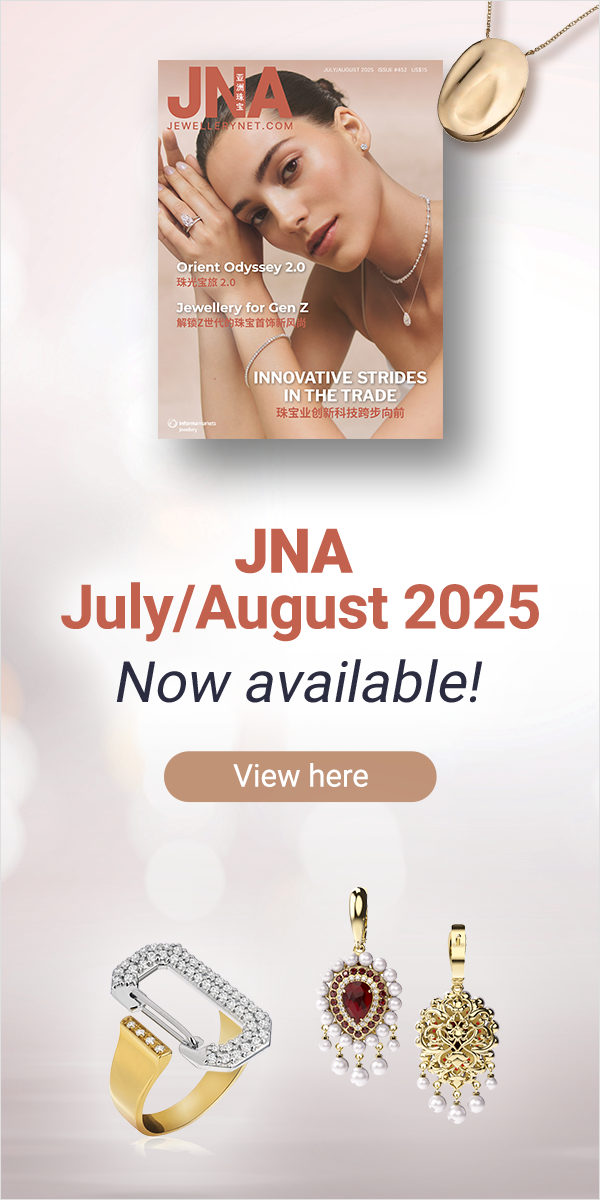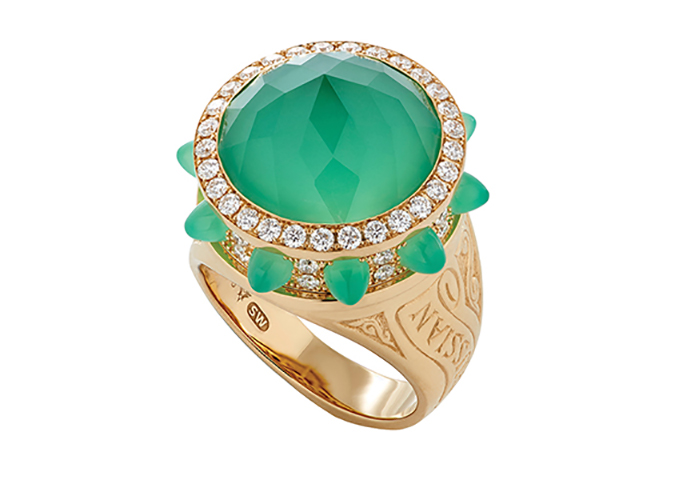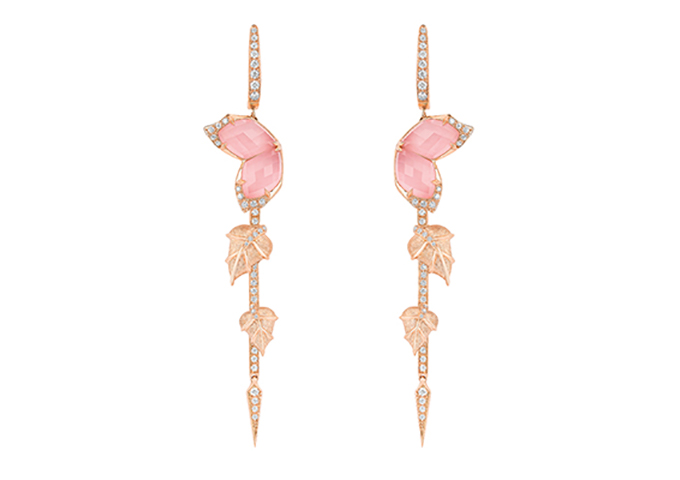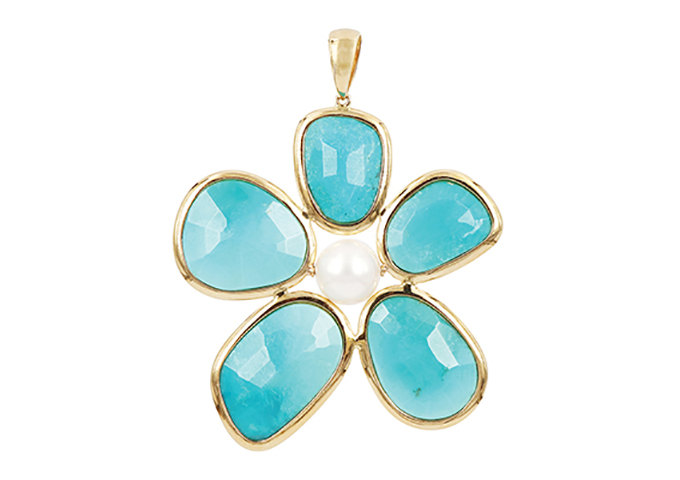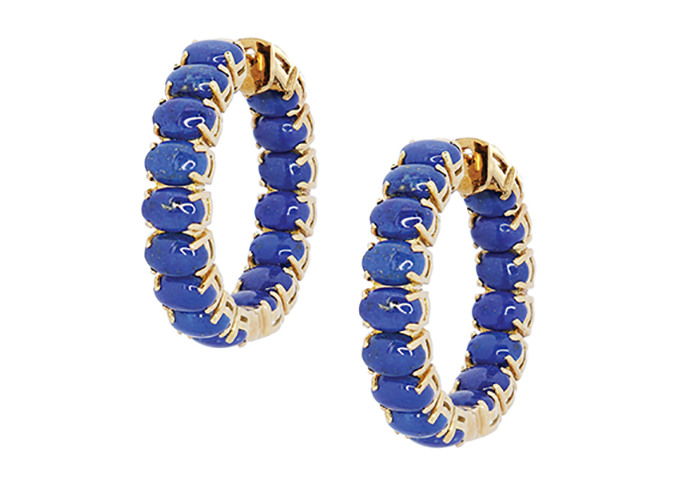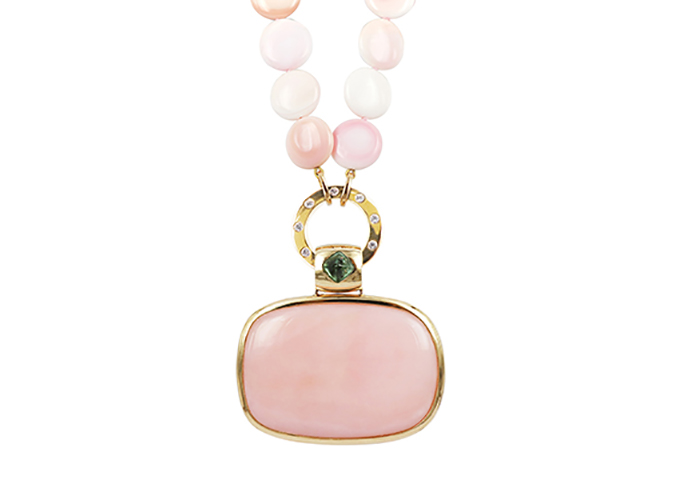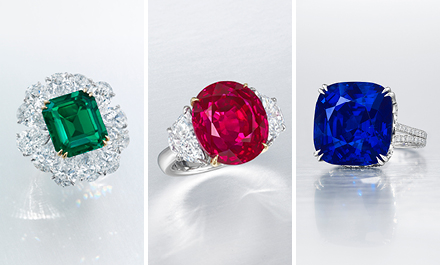Opaque gemstones are taking their rightful place in the jewellery world, catering to a customer demographic that values individuality and diversity in shape, colour and appearance. JNA examines some popular opaque gems in the market and their distinctive characteristics.
The compact, full-bodied, and at times dramatic, appearance of opaque gemstones is increasingly attracting attention in the jewellery and gemstone trade on the back of consumers’ relentless appetite for exceptionality.
Defined as neither transparent, which allows all light to pass through, nor translucent, which permits some light to pass through, an opaque gemstone transmits no light. It’s this quality that gives the gem colour density – a highly favoured trait in the jewellery trade.
Opaque gemstones were once mainly used in men’s jewellery, black gems in particular, or as accents or decorative elements. These distinctive characteristics now please the aesthetic palettes of an emerging consumer demographic.
Even high jewellery maisons are steadily using opaque gemstones in their fashion-forward collections. Boucheron’s Serpent Bohème features fine jewellery pieces embellished with malachite – an opaque green-to-dark green mineral with needle-like inclusions – and diamonds.
One of Bulgari’s most successful offerings, Divas’ Dream, also includes opaque jewellery pieces set in 18-karat gold with diamond accents. At the centre of these creations are well-loved opaque gems such as turquoise and lapis lazuli. The latter also figures a great deal in another hero collection of Bulgari, B.Zero1.
With the quest for individuality transcending all industries, fields of expertise and artistic expressions, opaque gems are rising to become a phenomenon in the jewellery world, offering a vast array of colours, shapes and patterns, and giving jewellery pieces a raw, more authentic character.
Solid sophistication
Award-winning jewellery designer Stephen Webster attested to the desirability of opaque material, long before gemstone faceting became a trend. He said opaques were considered more attractive due to the density of their colour. “In line with the trend toward jewellery and gems that reflect their natural origins, there are usually more obvious visual connections detectable in opaque material,” he noted.
Designers are likewise afforded more flexibility in fashioning an opaque stone. More practical gem-setting techniques, such as inlay work, demonstrate less formal and rigid processes to get the most out of a material, which meets the market’s preference for casual glamour.
Webster shared, “About 25 years ago, many of my clients would say that they could wear my pieces, containing many opaque gems, with blue jeans. I always took this as a compliment because it meant there were more opportunities to wear my jewellery, rather than for occasions only, which at the time was the reserve for most fine jewellery.”
Some of the most iconic Stephen Webster collections, such as Crystal Haze, shine the spotlight on opaque material. “I love using something beautiful but not necessarily glamorous and making it so through lapidary work and design,” he revealed. “I have been credited with this approach to fine jewellery. The democratisation of a rigid and classic industry is something I have enjoyed. It’s amazing how, if you treat it right, a lump of iron-heavy mineral such as hematite, can become a ‘must have’ as the hero of a cocktail ring.”
Webster disclosed that the US alongside Turkey, India and African countries have an opaque gem culture and these markets understand such material presented as cabochon, beads or inlay. Opaque jade meanwhile is an auspicious stone in Chinese culture. Jade comes in a variety of colours, with the most valuable being the classic apple green.
Distinct gems
According to Giuseppe Marotta of Italy-based gemstone trader Massa Gioconda Sas, a stone’s opacity is determined by its chemical composition, colour, depth, the presence or absence of inclusions, as well as surface condition.
Massa Gioconda specialises in coral and turquoise – two of the most coveted opaque stones in the trade.
Coral, an organic gem composed mainly of calcium carbonate, comes from the Pacific Ocean and the Mediterranean Sea. Depending on its origin, a coral’s characteristics vary according to colour and the consistency, size and presence of white spots. Coral comes in various shades of white to dark red.
The mineral turquoise meanwhile is a hydrated phosphate of copper and aluminium. Its colours range from sky-blue to green, depending on the amount of iron and copper it contains.
Marotta revealed that coral is highly favoured in China, Japan and Italy for its auspicious meaning, with red signifying luck and prosperity, as well as in India, Africa and the US.
The market for turquoise is strongest in the areas where they are mined, including Iran, the US and China. Japan has also become one of the biggest buyers of Persian turquoise stones, according to Marotta.
With the closure of the Sleeping Beauty turquoise mine in Arizona in 2012, the supply of turquoise has tightened while prices skyrocketed. Dealers mainly face the challenge of sourcing natural Sleeping Beauty turquoise and Sardinian coral – the rarest and the most beautiful variants of these gems.
Recently, the value of turquoise, like many other opaque gems, has been diminished with the proliferation of treated, imitation and synthetic stones in the market, revealed Marotta.
What makes these gems stand out is their authentic charm, preserved in the jewellery designs. According to Marotta, the rough material guides designers in determining the size, colour and shape of the final gem. “Our materials have compact colours and they represent historical and cultural value. They are competitively priced but their intensity and chromatic consistency make them unique,” he stated.
Power of colours
Opaque jewellery’s most attractive feature is the solid, vivid burst of colour, according to renowned designer Tayma Page Allies. This type of jewellery is also ideal for a working woman who is partial to office-appropriate jewellery – something that exudes strength, power, and impact minus the sparkle.
Labradorite and moonstone, which are varieties of the feldspar mineral, are popular opaque gems that possess a hint of “light and flash” within the stones, explained Allies.
Lapis lazuli is also a perfect gem for the office, thanks to its prized bright royal blue colour with golden flecks of pyrite that create glitzy undertones. Lapis lazuli likewise comes in darker shades of blue while some appear greyish or intense cobalt blue, making the stone ever more versatile.
Another rare and very feminine opaque gem is the Peruvian pink opal. Allies said while pink opal is not expensive, it can be set in an expensive setting of 18-karat gold to further inject sophistication to the piece.
“There’s great versatility in opaque stones. The more you think about it, the more you realise how many opaque gems there are and how diverse the designs can be,” remarked Allies. “Mostly we buy jewellery for the sparkle, but we buy opaque jewellery for the colour.”
The designer said she expects opaque gems to gain further traction in the jewellery trade as consumers continue to look for jewellery pieces that are more expressive, versatile and meaningful.
Opaque gems are also relatively more affordable than diamonds and other coloured gemstones although prices depend on the gemstone and the setting. “You can have a very inexpensive piece of lapis lazuli and an ultra-rare, top-colour piece. Equally in turquoise, there’s a cheap variety and the highly desired and exquisite Iranian or Sleeping Beauty turquoise,” she continued.
Increasing popularity
An opaque gem’s chemical structure varies from stone to stone, but majority of them fall under the chalcedony, agate and jasper family, shared Johnny Poon of Shanghai Jade Gems Factory Ltd.
Throughout the years, opaque gems have risen in popularity worldwide since the US, European and Asian markets are increasingly buying these stones.
With their eclectic colours, shapes, patterns and overall appeal, opaque gems also give jewellers extra room to maneuver and experiment with new designs in response to modern buyers’ call for individuality and jewellery pieces with compelling narratives.
Wearers also get to mix and match different pieces, thanks to the gems’ diverse appearances.
“Demand for opaque gems has been on the upswing in the last 10 years. Some gems, however, are harder to come by due to limited supply,” noted Poon. “Prices vary per gem. Unlike diamonds, which have published pricing charts, opaques are priced depending on the popularity, rarity and quality of the stone.”
For instance, ocean jasper from Madagascar, which Poon described as “the most beautiful and dynamic opaque gem,” has become rare in the market. Ocean jaspers were first brought to the Museum of Sciences in Paris, France in the 1950s but the location of its mine was only identified in 1997. Before long, it captured the fancy of traders and connoisseurs, and by 2006, resources were exhausted.
“No new deposits have since been discovered. This means that prices could soar and these gems will remain scarce,” he added.
Owing to the variety and rarity of opaque gems, providing jewellers with a steady and consistently high-quality supply remains a challenge, according to Poon.
Intense, impressive gems
One of the most alluring types of opaque stones are black diamonds. Earlier regarded as lowly variants of well-loved natural white diamonds, black diamonds are now turning heads in the jewellery industry as enigmatic, fascinating centre stones.
According to the Gemological Institute of America (GIA), most natural black diamonds acquire their colour from large quantities or clouds of minute mineral inclusions such as graphite, pyrite or hematite that extend throughout the stone.
Natural-colour black diamonds typically are completely opaque, with a high lustre that gives the stones an almost metallic appearance. “And because these diamonds are so heavily included, cutting and polishing them can be difficult. They also must be set with great care,” noted GIA.
A fine natural-colour black diamond is exceptional and often more affordable than other diamonds.
Majority of black diamonds sold for jewellery and engagement rings however have been treated to induce the colour. Many begin as grey, heavily included and fractured diamonds that are subjected to high-temperature/low-pressure treatment, which graphitises the fractures, turning them black, GIA said.
Navneet Agarwal of Navneet Gems & Minerals Ltd said the appeal of black diamonds is stronger in price-point markets in the US and Europe. Asian buyers are not too partial to black diamonds mainly due to cultural or religious preferences, he added.
Black diamonds could sell for anywhere between US$20 to US$200 per carat.
At the moment, there is enough supply in the market for these stones.
Bharat Patel, director of Abee Impex Ltd, said black diamonds are used mainly for fashion jewellery due to its competitive price. The Hong Kong-based company’s biggest markets for black diamonds are the US and Japan. Depending on the quality of the stone, Patel said black diamonds could fetch US$30 to US$250 a carat.
Amid the pandemic, black diamond producers are finding new ways to engage with customers, especially through e-commerce. With strong online sales, there is currently a shortage of good-quality black diamonds in smaller sizes of 1.3mm, revealed Patel.



